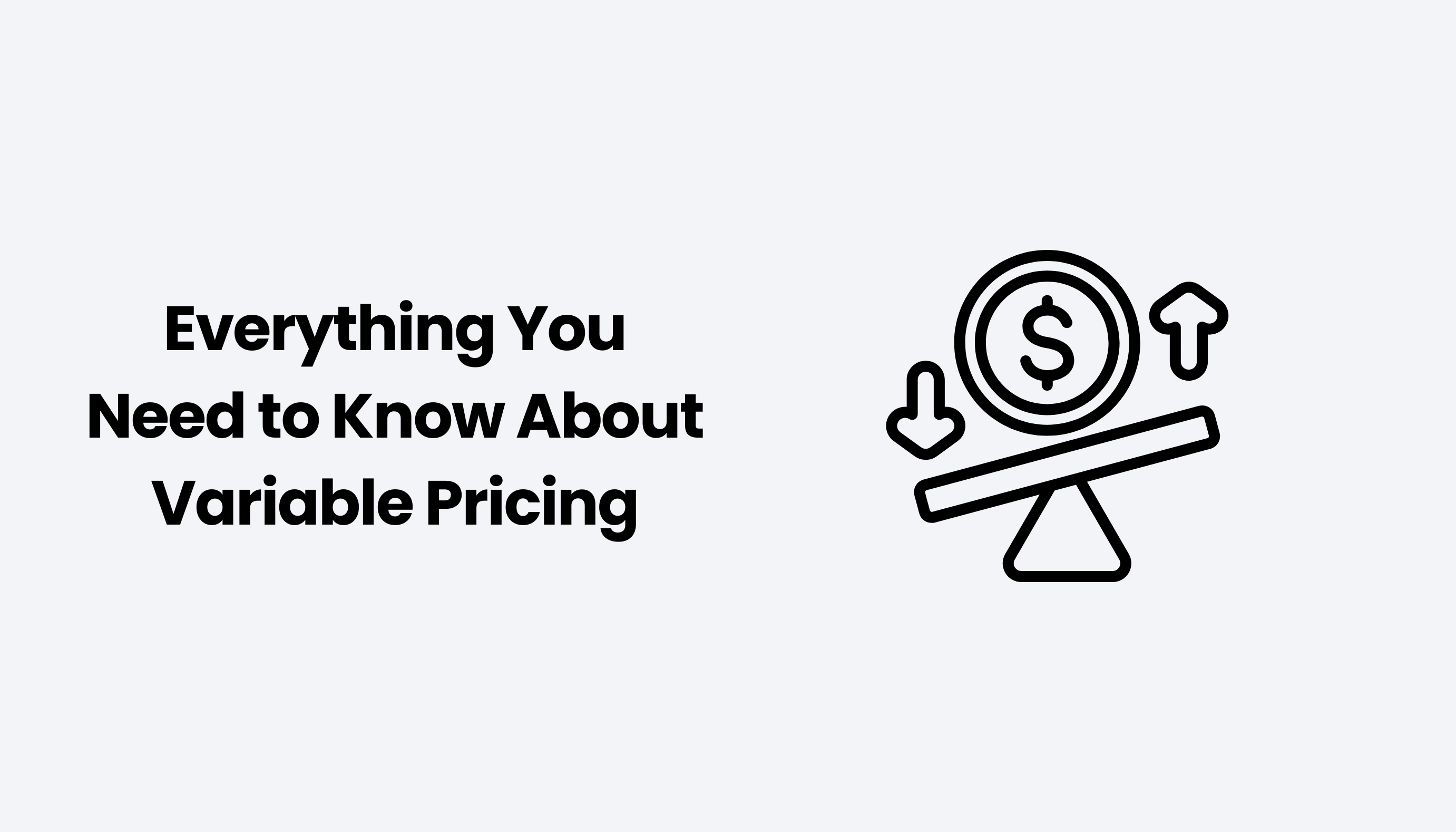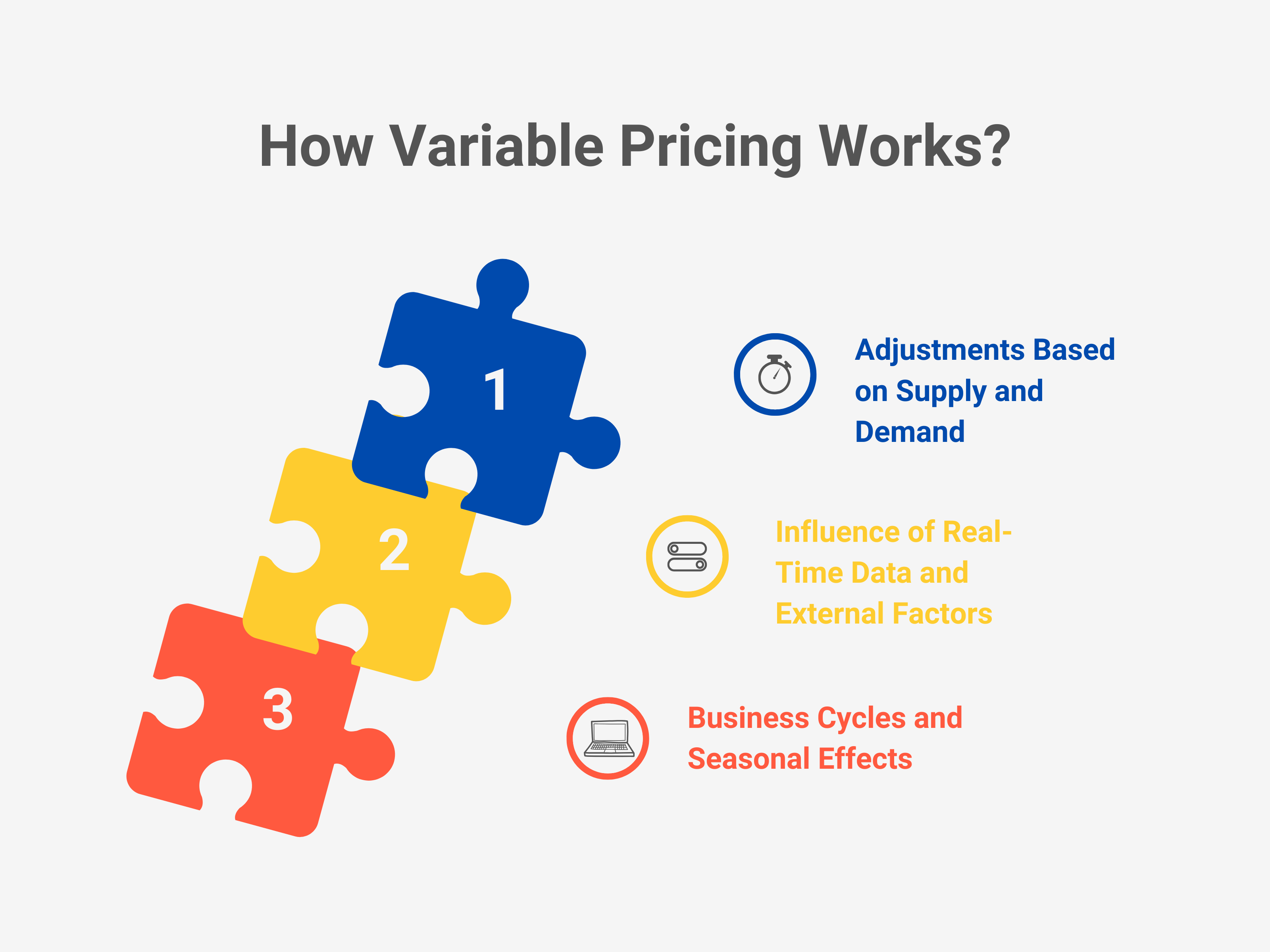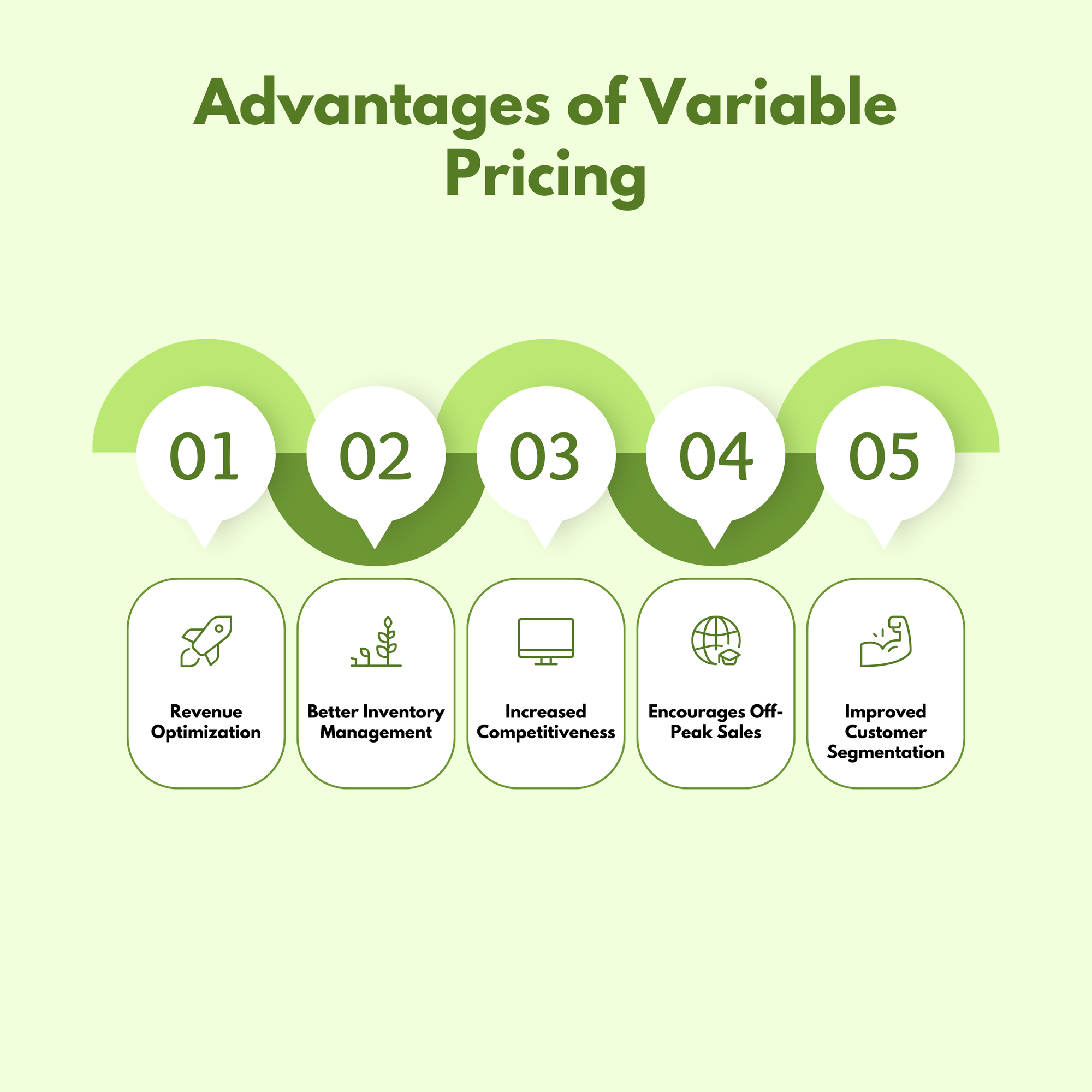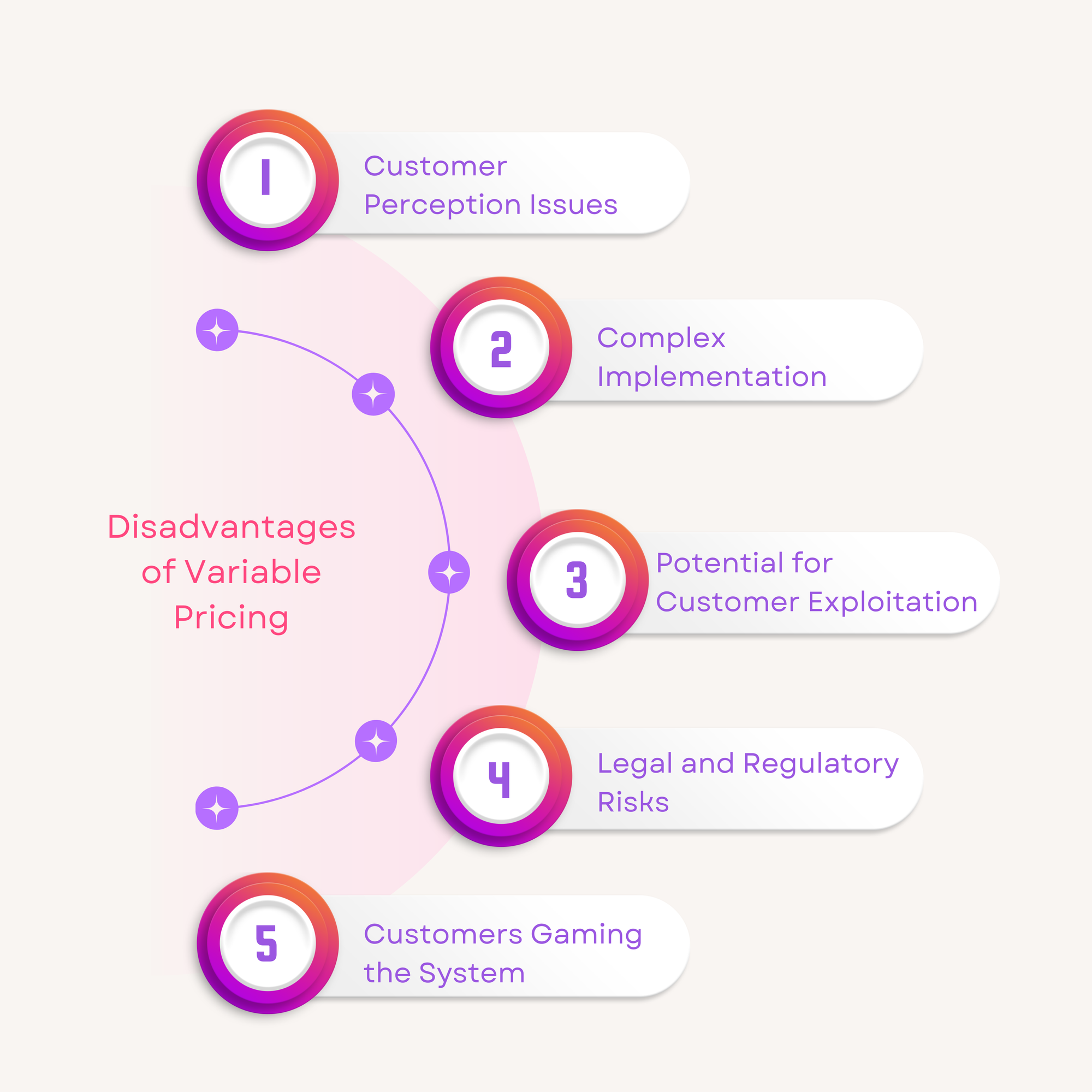Everything You Need to Know About Variable Pricing

Pricing plays a crucial role in shaping a business’s profitability, competitiveness, and customer perception. While fixed pricing offers stability, it often fails to capture the full potential of shifting market conditions. This is where variable pricing comes in—a strategy that adjusts prices based on factors like demand, location, seasonality, and customer demographics. From airlines and e-commerce platforms to ride-sharing services and event ticketing, businesses across industries leverage variable pricing to maximize revenue, manage inventory, and attract customers at the right time.
This guide provides a comprehensive overview of variable pricing, covering its key principles, different pricing models, real-world applications, and the advantages and challenges businesses must consider.
Table of Contents:
- What is Variable Pricing?
- How Variable Pricing Works?
- Industries That Use Variable Pricing
- Variable Pricing Models
- Advantages of Variable Pricing
- Disadvantages of Variable Pricing
- Key Strategies for Success with Variable Pricing
Jump to a section that interests you, or keep reading.
What is Variable Pricing?
Variable pricing is a pricing method where the cost of a product or service fluctuates based on demand, supply, and external factors. This model allows businesses to charge higher prices when demand is strong and lower prices when demand weakens. It is widely used in industries where demand shifts frequently, such as airlines, hotels, e-commerce, and ride-sharing services. Unlike fixed pricing, where a product maintains a consistent price regardless of market conditions, variable pricing continuously adjusts to maximize revenue and maintain balance between supply and demand.
Variable pricing is often referred to by different names depending on its application. "Dynamic pricing" is a common term used in industries where prices change in real-time based on demand fluctuations. "Surge pricing" is a variation of this concept, notably used by ride-sharing companies like Uber, where prices increase sharply during periods of high demand. Other related terms include "price smoothing," which refers to gradual price adjustments over time, and "price lining," where businesses offer products at predefined price levels based on demand and perceived value.
How It Differs from Fixed Pricing?
Fixed pricing involves setting a stable price for a product or service that remains unchanged regardless of demand or market conditions. This approach is straightforward and predictable for consumers, but it limits a business’s ability to respond to fluctuations in demand. In contrast, variable pricing is flexible, allowing businesses to adjust prices based on various factors such as time, seasonality, and customer segmentation. For example, airlines and hotels use variable pricing to charge higher rates during peak travel seasons and lower rates during off-peak times, whereas a fixed pricing model would not adapt to these shifts.
Key Principles Behind Variable Pricing
Several principles govern how variable pricing is applied:
-
Demand-Driven Adjustments: Prices increase when demand is high and decrease when demand is low to optimize revenue. This is commonly seen in ride-sharing, where fares rise when driver availability is low compared to rider demand.
-
Market Responsiveness: Prices reflect real-time supply and demand conditions. Businesses in e-commerce use this approach by altering prices based on competitor pricing and customer behavior.
-
Segmentation-Based Pricing: Different customer groups may receive different price points based on location, demographics, or purchasing behavior. Some software companies apply customized pricing where enterprise clients pay more for advanced features.
-
Seasonal and Event-Based Pricing: Certain industries adjust prices based on seasonal trends. Hotels and airlines raise prices during holiday seasons, while retail businesses offer discounts on slow-moving inventory.
-
Auction-Based and Bidding Models: Prices are determined by competition among buyers, as seen in eBay auctions and stock market pricing, where buyers influence the final purchase cost.
-
Profit Optimization Over Time: Businesses use variable pricing to control inventory flow and avoid lost revenue opportunities. For instance, companies lower prices during off-peak periods to attract more buyers and raise prices when demand surges.
How Variable Pricing Works?

Adjustments Based on Supply and Demand
Variable pricing operates by modifying prices in response to changes in supply and demand. When demand rises, prices increase to maximize revenue, whereas lower demand results in reduced prices to attract buyers. This principle is evident in industries like airlines and hotels, where peak periods lead to higher rates, while off-season periods see lower prices to maintain occupancy. Similarly, ride-sharing platforms raise fares when driver availability is low compared to rider demand. The approach ensures that businesses can control product distribution and maintain profitability by pricing their goods and services according to market conditions.
Influence of Real-Time Data and External Factors
Businesses implementing variable pricing rely on real-time data to adjust prices dynamically. Companies track consumer behavior, competitor pricing, and external market conditions to determine optimal price points. E-commerce platforms use algorithm-driven models to continuously analyze data and modify product prices accordingly. Ride-sharing apps adjust pricing based on traffic conditions, driver supply, and regional demand spikes. External factors such as economic shifts, holidays, and major events also influence pricing decisions, as seen in hotel and airline industries, where prices surge during peak travel seasons.
Business Cycles and Seasonal Effects
Variable pricing is closely linked to business cycles and seasonal demand fluctuations. Many industries experience predictable demand patterns based on time of year, day of the week, or even time of day. Hotels and airlines adjust rates according to travel seasons, while retailers lower prices during off-seasons to clear inventory. Sporting events and concerts also see price shifts based on scheduling and anticipated attendance levels. By aligning pricing strategies with business cycles, companies can stabilize revenue streams and optimize sales throughout different periods.
Industries That Use Variable Pricing
Travel & Hospitality: Airlines, Hotels, Rental Cars
The travel industry is one of the most prominent users of variable pricing. Airlines frequently adjust ticket prices based on demand, booking trends, and travel dates. Hotel pricing fluctuates based on occupancy rates, seasonality, and major events in a given location. Rental car companies also modify rates depending on fleet availability and travel trends. The pricing model ensures that businesses in this sector capitalize on high-demand periods while offering competitive rates during slow periods to attract customers.
E-commerce: Amazon, eBay (Auctions, Algorithm-Driven Pricing)
E-commerce platforms employ variable pricing through dynamic adjustments and auction-based sales. Amazon modifies product prices frequently using algorithm-driven pricing that factors in competitor rates, customer demand, and purchasing trends. eBay utilizes an auction model where product prices are determined by buyer competition, leading to fluctuating final sale prices. This strategy allows online retailers to maximize revenue while maintaining competitive positioning in the market.
Ride-Sharing & Transportation: Uber, Lyft (Surge Pricing)
Ride-sharing services implement surge pricing, a form of variable pricing that increases fares during high-demand periods. Uber and Lyft raise prices when there is an imbalance between rider requests and driver availability. This approach incentivizes more drivers to be on the road while ensuring that customers willing to pay the higher rate receive timely service. The pricing model also accounts for factors such as weather conditions, special events, and time of day to optimize fare adjustments.
Entertainment & Events: Sports Tickets, Movie Theaters, Amusement Parks
The entertainment industry uses variable pricing to adjust ticket costs based on event popularity and availability. Sports teams alter ticket prices based on demand, with marquee matchups commanding higher rates. Movie theaters may introduce variable pricing for peak showtimes and blockbuster releases. Amusement parks set different rates depending on the season, with peak times like holidays and summer vacations leading to higher ticket prices. This strategy ensures that businesses maximize ticket revenue while balancing visitor flow.
Retail: Demand-Driven Pricing Strategies
Retailers incorporate variable pricing by adjusting product costs in response to sales trends and inventory levels. Discounts and promotional pricing are used to stimulate demand for slow-moving products, while in-demand items may be priced higher. Some retailers also utilize location-based pricing, where stores in high-traffic areas charge more for the same product compared to stores in less competitive regions. The flexibility of this approach enables businesses to maintain profitability while responding to consumer purchasing patterns.
Stock Market & Auctions: Bidding-Driven Pricing
Variable pricing is a fundamental principle in stock markets and auction platforms. In the stock market, share prices fluctuate based on trading activity, investor sentiment, and economic indicators. Bidding-driven pricing is also prevalent in auction-based sales, where the final price is determined by competitive offers from buyers. Platforms like eBay use this model to establish product pricing dynamically, ensuring that sellers receive the highest possible return based on market demand.
Variable Pricing Models
Demand-Based Pricing
Demand-based pricing adjusts prices in response to fluctuations in demand. When demand is high, prices increase to maximize revenue, whereas lower demand leads to reduced prices to attract buyers. This approach ensures that businesses optimize profits while managing product or service availability. A common example is airline ticket pricing, where fares rise as seats fill up and drop during off-peak times. Ride-sharing services like Uber use surge pricing, increasing fares when rider demand surpasses driver availability.
Location-Based Pricing
Location-based pricing adjusts prices depending on geographic factors such as store location, regional purchasing power, and market competition. Businesses charge higher prices in areas with greater demand or limited availability while offering lower prices in less competitive regions. For instance, products sold at airport stores are more expensive than in supermarkets due to convenience and captive customer demand. Similarly, urban stores with higher operating costs often have higher prices compared to rural stores where competition may be lower.
Group-Based Pricing
Group-based pricing segments customers based on demographics such as age, occupation, or purchasing behavior, offering different prices to different groups. Students, seniors, and military personnel often receive discounts as part of targeted pricing strategies. While this approach allows businesses to cater to specific audiences, it raises ethical and legal concerns regarding potential discrimination. Some jurisdictions regulate such practices to ensure fair pricing and prevent exploitation based on demographic segmentation.
Dynamic Pricing
Dynamic pricing involves real-time price adjustments based on shifting demand patterns. Businesses use AI-driven algorithms to analyze factors such as competitor pricing, purchasing trends, and market conditions to determine optimal price points. This model is widely used in e-commerce, where platforms like Amazon frequently update product prices. Hotels, airlines, and rental car services also employ dynamic pricing, adjusting rates minute by minute based on booking trends and external events.
Bundling
Bundling combines multiple products or services into a single package at a discounted price. This pricing model increases perceived value and encourages customers to buy more. Restaurants offer combo meals, including a main dish, side, and drink for a lower price than purchasing each item separately. Retailers provide bulk discounts, where buying larger quantities results in a lower per-unit cost. Bundling helps businesses increase sales volume while clearing inventory more efficiently.
Penetration Pricing
Penetration pricing involves introducing a product or service at a low price to attract customers and establish market presence. Once a business gains a customer base, it gradually increases prices. This strategy is common in subscription-based industries, where new streaming services offer discounted introductory rates before raising monthly fees. It allows businesses to build brand loyalty and drive initial adoption while planning for long-term profitability.
Skimming Pricing
Skimming pricing starts with high initial prices that gradually decrease over time. This strategy is used for new, innovative products that attract early adopters willing to pay a premium. As demand stabilizes and competition increases, businesses lower prices to reach broader consumer segments. Apple follows this model with iPhone launches, setting high prices at release and reducing them once newer models arrive. This approach helps businesses maximize revenue from early adopters before adjusting to competitive market conditions.
Customized Pricing
Customized pricing tailors prices to individual customer needs and usage patterns. This approach is prevalent in industries offering tiered pricing structures based on feature selection. Software companies like Salesforce offer different pricing plans depending on the functionalities a customer requires. Enterprise clients may receive personalized pricing based on the scale of implementation. This model ensures that customers pay for what they need while businesses optimize revenue.
Pay-What-You-Want
In pay-what-you-want pricing, customers decide how much they are willing to pay for a product or service. This unconventional model is often used by businesses that prioritize customer goodwill and voluntary contributions. The Humble Bundle, a digital game distributor, allows users to set their own price for game bundles, with proceeds supporting charity. Some donation-based businesses also use this model, relying on customer generosity to sustain operations. While risky, it can build strong customer relationships and brand loyalty.
Advantages of Variable Pricing

Revenue Optimization: Maximizing Profits in High-Demand Periods
Variable pricing allows businesses to increase prices when demand is high, maximizing revenue without additional costs. By charging more when customers are willing to pay a premium, businesses capture higher profit margins. This is especially useful in industries like airlines, hotels, and ride-sharing, where demand fluctuates based on factors such as time of day, seasonality, and external events.
Better Inventory Management: Controlling Supply Flow
By adjusting prices according to demand, businesses can regulate inventory levels more efficiently. Higher prices during peak demand prevent stock depletion too quickly, ensuring availability for high-value customers. Conversely, lowering prices during low-demand periods helps move excess inventory, reducing storage costs and preventing losses due to unsold goods. This pricing model is particularly effective in retail and e-commerce, where companies need to balance supply with shifting customer demand.
Increased Competitiveness: Adapting to Market Trends
Businesses using variable pricing can respond to competitor pricing strategies and market conditions in real-time. By adjusting prices dynamically, companies remain competitive without sacrificing profitability. This is evident in e-commerce platforms, where automated pricing algorithms ensure that products remain attractively priced compared to competitors. The ability to change prices based on consumer behavior and external factors gives businesses an edge over those using fixed pricing models.
Encourages Off-Peak Sales: Attracting Customers During Slow Times
By offering lower prices during off-peak periods, businesses can drive sales when demand is typically low. This helps smooth out revenue streams and ensures steady cash flow. Hotels reduce rates during off-seasons to attract more guests, while restaurants offer discounted meals during non-peak hours to maintain customer traffic. Ride-sharing services lower fares during non-busy times to encourage riders, balancing driver availability and demand.
Improved Customer Segmentation: Charging Based on Willingness to Pay
Variable pricing enables businesses to target different customer segments with tailored price points. Price-sensitive buyers can take advantage of lower rates, while those willing to pay more for convenience or exclusivity contribute higher revenue. This segmentation is widely used in software subscription models, where different tiers cater to varied customer needs. Similarly, airline ticket pricing varies depending on factors such as booking time and travel flexibility, ensuring maximum revenue from each customer category.
Disadvantages of Variable Pricing

Customer Perception Issues: Pricing Unfairness and Backlash
One major drawback of variable pricing is that customers may perceive it as unfair, especially when they see different prices for the same product or service. If a customer purchases an item only to find out that the price has dropped shortly after, frustration and dissatisfaction can arise. This can lead to negative reviews, reduced trust, and damage to a company’s reputation. Ride-sharing services and airlines often face criticism when prices surge unexpectedly during peak times or emergencies, making customers feel exploited rather than valued.
Complex Implementation: Need for Advanced Data Analytics
Effectively managing variable pricing requires businesses to track demand patterns, competitor pricing, and customer behavior in real-time. This demands sophisticated pricing algorithms, AI-driven models, and continuous data analysis, which can be costly and technically challenging. Without the right infrastructure, companies may struggle to adjust prices optimally, leading to lost revenue or reduced competitiveness. Additionally, businesses need to maintain transparency in their pricing methods to avoid alienating customers who feel prices are unpredictable or manipulated.
Potential for Customer Exploitation: Ethical Concerns
While variable pricing aims to maximize profits, it can sometimes be seen as taking advantage of customers during high-demand periods. Price spikes in essential services, such as transportation and lodging during emergencies or major events, can create ethical concerns. Customers may feel they are being forced to pay excessive amounts for necessities, leading to public criticism. This issue is particularly prevalent in industries like ride-sharing, where surge pricing can make fares prohibitively expensive when people need transportation the most.
Legal and Regulatory Risks: Pricing Discrimination Lawsuits
Charging different customers varying prices based on location, demographics, or perceived ability to pay can raise legal and regulatory concerns. Some group-based pricing models may be considered discriminatory, leading to lawsuits and fines. Companies must ensure compliance with pricing regulations to avoid legal disputes. In industries like insurance and financial services, strict rules govern how businesses can adjust prices for different customer segments, limiting the extent to which variable pricing can be applied.
Customers Gaming the System: Waiting for Lower Prices Instead of Buying
When customers recognize that prices fluctuate, they may delay purchases in anticipation of future discounts. This behavior can disrupt sales cycles and reduce revenue predictability. For example, consumers may wait for seasonal sales or promotional periods instead of purchasing at regular prices. In e-commerce, customers often track price trends or use tools that notify them when prices drop, making it harder for businesses to maintain steady sales at profitable price points.
Key Strategies for Success with Variable Pricing
Start with Simple Rules
Before introducing complex pricing algorithms, businesses should begin with straightforward pricing rules based on demand trends, supply levels, and competitive pricing. Establishing a baseline model allows for smoother implementation and reduces the risk of pricing miscalculations that could negatively impact sales or customer trust. For example, an airline may start by adjusting fares based on high and low travel seasons before introducing real-time demand-based price fluctuations.
Focus on Goals Over Optimization
Variable pricing should align with broader business objectives rather than focusing solely on price fluctuations. Whether the goal is to increase revenue, attract more customers, or gain market share, pricing adjustments should support these priorities. For example, a new streaming service may use penetration pricing—offering low initial rates—to quickly grow its subscriber base before gradually increasing prices. Similarly, a ride-sharing company might prioritize expanding into new markets with competitive fares rather than maximizing short-term profits.
Use Relative Pricing Comparisons
Customers assess pricing based on comparisons rather than absolute value, so businesses should carefully structure their pricing tiers and discounts. A well-balanced pricing model considers base prices, promotions, and surcharges to maintain perceived fairness. For instance, bundling products at a slight discount rather than offering unpredictable price swings can prevent customers from feeling overcharged while still driving higher sales volume.
Avoid Letting Consumers Dictate Prices
While dynamic pricing allows for flexibility, businesses should maintain control over perceived value. Relying too heavily on frequent discounts or reactive price changes can erode pricing power and brand positioning. If customers learn to expect frequent sales or time their purchases for discounts, businesses may struggle to sell products at full price. Instead, companies should structure promotions strategically while maintaining consistent value perception.
Use Technology & Data Analytics
Advanced pricing strategies rely on AI-driven models and real-time data tracking to optimize pricing decisions. Businesses should invest in technology that monitors demand fluctuations, competitor pricing, and customer behavior to refine pricing adjustments. E-commerce platforms like Amazon use algorithm-driven pricing to remain competitive, while ride-sharing services employ real-time surge pricing to adjust fares based on driver availability and ride requests. Proper use of data analytics ensures pricing changes remain responsive and aligned with business objectives.
Conclusion
Variable pricing is a powerful tool when used strategically, allowing businesses to adjust prices in response to real-time market conditions. It offers benefits such as increased revenue potential, improved inventory management, and the ability to attract customers during off-peak periods. However, it also comes with challenges, including customer perception issues, legal risks, and the complexity of implementation.
For businesses, the key to successful variable pricing lies in balancing flexibility with fairness. Clear pricing rules, data-driven decision-making, and a focus on long-term goals help companies avoid pitfalls while maximizing profitability. As technology continues to evolve, businesses that embrace smart pricing strategies will be better positioned to stay competitive in dynamic markets.
